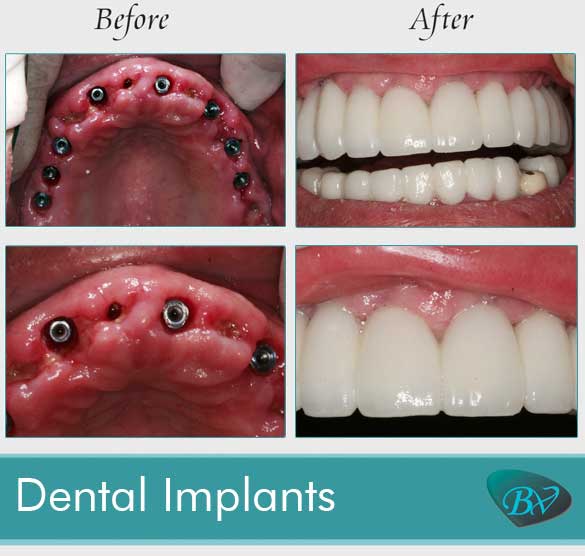The Only Guide to Dental Sense
The Only Guide to Dental Sense
Blog Article
The Best Guide To Dental Sense
Table of ContentsSome Known Details About Dental Sense Dental Sense Fundamentals ExplainedDental Sense for DummiesThe Basic Principles Of Dental Sense
are medical devices surgically implanted right into the jaw to recover an individual's capacity to eat or their appearance. They supply support for artificial (fake) teeth, such as crowns, bridges, or dentures. When a tooth is lost because of injury or illness, an individual can experience complications such as quick bone loss, malfunctioning speech, or changes to chewing patterns that cause discomfort.Oral dental implant systems are composed of an oral implant body and oral implant abutment and may likewise consist of an abutment fixation screw. Root canal procedure. The dental implant body is operatively put in the jawbone in area of the tooth's origin. The dental implant abutment is generally affixed to the dental implant body by the abutment fixation screw and expands via gums into the mouth to support the connected artificial teeth
(https://anotepad.com/note/read/pydwx7ht)Framework of The Dental Implant System picking dental implants, speak to your oral company concerning the prospective advantages and risks, and whether you are a prospect for the treatment. Things to consider: Your overall health is an important factor in figuring out whether you are a good candidate for dental implants, the length of time it will certainly take to recover, and for how long the dental implant might remain in location.
Smoking may affect the healing procedure and reduce the long-lasting success of the dental implant. The healing process for the implant body may take several months or longer, during which time you typically have a short-term abutment in location of the tooth. the dental implant procedure: Thoroughly adhere to the oral health directions provided to you by your oral supplier.
6 Simple Techniques For Dental Sense
Implant failure can lead to the need for another surgical procedure to fix or change the dental implant system. Restores the capacity to eat Recovers aesthetic appearance Aids maintain the jawbone from shrinking because of bone loss Preserves the health of the bordering bone and gums Helps maintain adjacent (close-by) teeth stable Enhances quality of life Damage to surrounding all-natural teeth throughout implant placement Injury to the surrounding cells throughout surgical procedure, such as sinus opening Injury during surgical procedure (for instance, crack of surrounding jawbone) Poor function, such as seeming like the teeth do not bite with each other normally A feeling that the tooth is loosened or twisting in place resulting from a joint screw loosening up Implant body failure (looseness of the implant body) as a result of systemic infection, which may be most likely in patients with uncontrolled diabetes mellitus as a result of local infection in bone and periodontals sustaining the implant body because of postponed healing, which may be more probable in individuals who smoke Difficulty cleaning up the periodontals around the dental implant, resulting in inadequate oral hygiene Without treatment periodontal illness Post-surgical pins and needles because of nerve impingement or damage Constantly notify healthcare companies and imaging technicians that you have dental implants prior to any type of magnetic resonance imaging (MRI) or x-ray treatments.
FDA is not familiar with any kind of unfavorable occasions reported for MRI or x-ray procedures with oral implants. Oral implants systems are typically made of materials that follow worldwide agreement criteria of the International Organization for Standardization (ISO) or ASTM International. These standards have details of what makes a secure product.

An oral implant is a structure that replaces a missing tooth. With screw-like tools, the specialist inserts a dental implant right into the jawbone, and it acts as a support for a synthetic tooth, called a crown.
The Greatest Guide To Dental Sense
Some people are not qualified for dental implant surgical treatment. It is for dental cosmetic surgeons to run on people with: acute illnessuncontrollable metabolic diseasebone or soft cells illness or infectionIf these issues are fixed, an individual can have the surgical treatment. In, oral specialists abstain from operating individuals with: If individuals with any one of the above undergo oral implant surgical procedure, there is a greater danger of the dental implant failing.

Dental implant surgical procedure is an individualized procedure. Offer you time to recover. Connect the message and last crown, bridge or denture.
Next, your specialist will carefully position the dental implant right into your jaw. If your implant is near the front of your mouth, your dental professional will make a short-term tooth for you to put on till you recover.
The Greatest Guide To Dental Sense
Your copyright can tell you what to anticipate in your circumstance. During the healing stage, your jawbone must fuse to the oral implant. This process, called osseointegration, is essential for stability and lasting success. This process can take anywhere from 3 to nine months. Sometimes, it may take much longer.
When your dental implant heals, your dental professional can affix the abutment (little connector blog post) and your final repair (crown, bridge or denture). This typically takes concerning one hour to finish and might need a second small surgical treatment. You shouldn't feel any kind of pain during your oral implant procedure due to the fact that your provider will certainly use medication to numb your gums.
Report this page